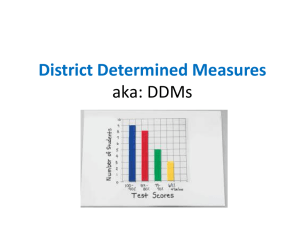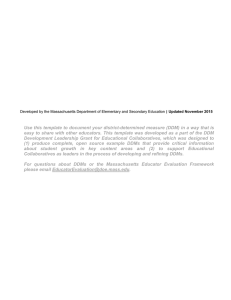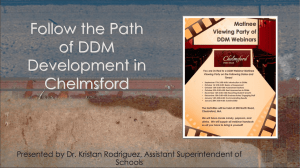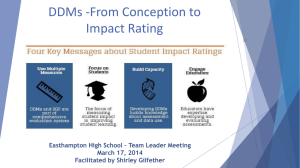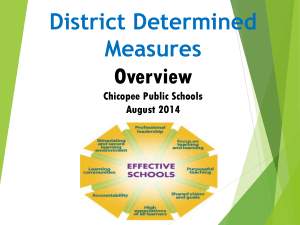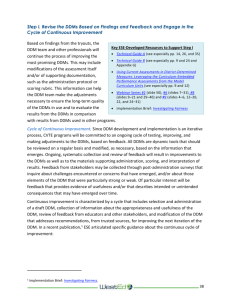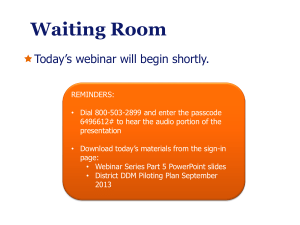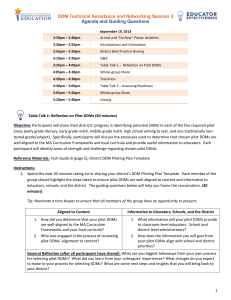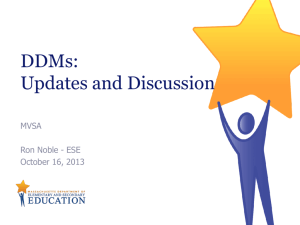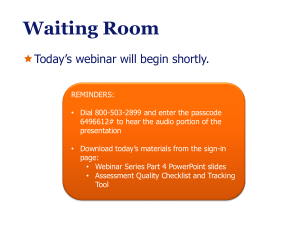Power Point on DDMs - Norwood Public Schools
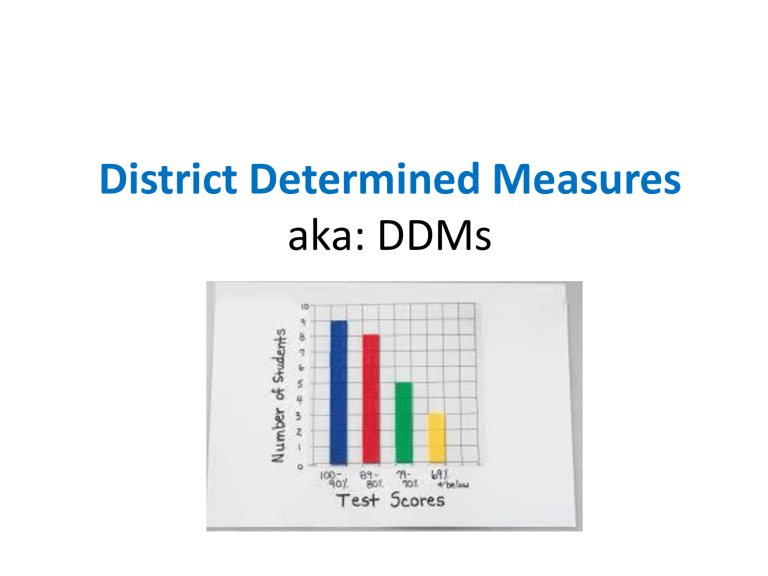
District Determined Measures aka: DDMs
The Challenge:
The Essential Questions:
1. How can I show, in a reliable and valid way, my impact on students’ learning something important over the course of the year?
2. What data do I already collect, or do I need to collect, that will show my students’ growth that is fair to all groups of students?
3. Does this data fairly and accurately represent my impact on the students I teach or work with?
What is a DDM?
• Think of a DDM as an assessment tool similar to MCAS.
• It is a measure of student learning, growth, and achievement related to MA curriculum frameworks or other relevant set of professional standards for a particular discipline.
• But, a DDM can also be unlike MCAS:
– A portfolio
– A capstone project
– A commercial assessment (e.g., DRA2, Lexia Core5)
– ACCESS for ELLs
– Indirect measures: Attendance/discipline/graduation rates, course taking patterns, social/emotional/behavioral learning over time. Useful for Specialized Instructional Support Personnel
(SISP) .
What Qualities Must a DDM Have ,
especially since it is tied to teacher evaluation
?
1.
Must be aligned to and target most the important learning standards , or objectives/student outcomes, for grade level & content area (content
validity).
2.
Must be informative : informs educators about where students fall short or excel; measures students’ progress/growth effectively. Tells us something useful.
3.
Must be free of any bias (e.g., non-verbal students, cultural/vocabulary backgrounds). All groups of students (honors and disabled) should have an equal chance to demonstrate growth.
4.
Has common administration protocols. Note: Testing accommodations on a student’s IEP must also be implemented for DDMs.
5.
Has a common scoring guide and process.
6.
Will yield a range of performance & growth : high, moderate, low.
Moderate = 1 year’s progress. Needs to discriminate between strong and weak performers.
7.
Are equally rigorous across schools, grades, and content areas.
Four Basic Types of DDMs
1.
Pretest and Posttest
2.
Repeated Measures (done in short, regular intervals: e.g., DRA2 or running records,
Lexia Core5 or Strategies for Older Students)
3.
Holistic Evaluation (e.g., portfolio)
4.
Posttest only (e.g., end of unit, term, or course assessments; capstone project)
Note: A DDM should show growth over a year.
One can use a series of units to do so.
What is Required of All Educators?
• At least 2 DDMs per educator used over a 2 year period to measure
Impact on Student Learning (typically not for the same students)(exceptions: adjustment counselor’s case load).
• 2013-14: Pilot as many DDMs as possible.
• 2014-15: 1st year implementation of joint committee approved
DDMs.
• 2015-16 (2016-17 with extension): As part of new Educator
Evaluation System, educators receive first round of Impact ratings
(high, moderate, low) based on two years of data and collaborative
(educator/evaluator) professional judgment .
Note: “Moderate” growth is defined as 1 year’s progress/growth
over 1 year’s time and relative to one’s academic peers; the amount of growth we would reasonably expect for a student over one school year relative to his/her academic peers.
Two Ratings for All Educators
Exemplary
1-yr Self-Directed
Growth Plan
2-yr Self-Directed Growth Plan
Proficient
Needs
Improvement
Directed Growth Plan
Unsatisfactory
Impact Rating on
Student
Performance
Improvement Plan
Low Moderate High
Rating of Impact on Student Learning
( Using two or more DDMs over two years : multiple measures of performance, including MCAS Student Growth Percentiles and ACCESS where available)
7
2 DDMs over 2 Years : Some Scenarios
If you teach or do… You need or can use…
1. Multiple subjects (e.g.,
K/elementary level).
2. One subject or grade level course only (e.g. middle school).
3. Multiple courses and/or grades (e.g., high school).
4. Specialized Instructional
Support (for SISP).
5. “Co-teachers” (e.g. Title 1,
ELL, SpEd): use same
DDMs/SGPs.
1.
1 DDM for ELA; 1 DDM for math
(Gr 4 & 5: must use 1 MCAS SGP ; can use both ELA & Math SGP).
2.
2 DDMs for that subject or course for all sections (Gr 6-8: 1 must be MCAS SGP for ELA & math teachers ).
3.
You and your supervisor will need to identify which two courses’ DDMs to use that best represent the core of your work.
4.
Portfolio; Indirect Measures
(e.g., attendance, discipline, or behavioral data, etc.).
What Needs to be Done by When?
• By June 1, 2014 , all districts need to submit to DESE a DDM implementation plan for 2014-15 onward.
• District DDM Plan needs to indicate the two-three DDMs to be developed and used for each grade level, course, or role.
• Recommendation: Use what assessments you currently have and modify them to meet DESE standards for DDMs.
• A joint committee (elementary & secondary) has been formed to review and approve all DDMs before they are used as part of the Educator Evaluation System. This group will also determine how to use DDM results to determine
Impact Ratings.
Note: All DDM work will be eligible for PDP credit.
The Challenge:
The Essential Questions:
1. How can I show, in a reliable and valid way, my impact on students’ learning something important over the course of the year?
2. What data do I already collect, or do I need to collect, that will show my students’ growth that is fair to all groups of students?
3. Does this data fairly and accurately represent my impact on the students I teach or work with?
